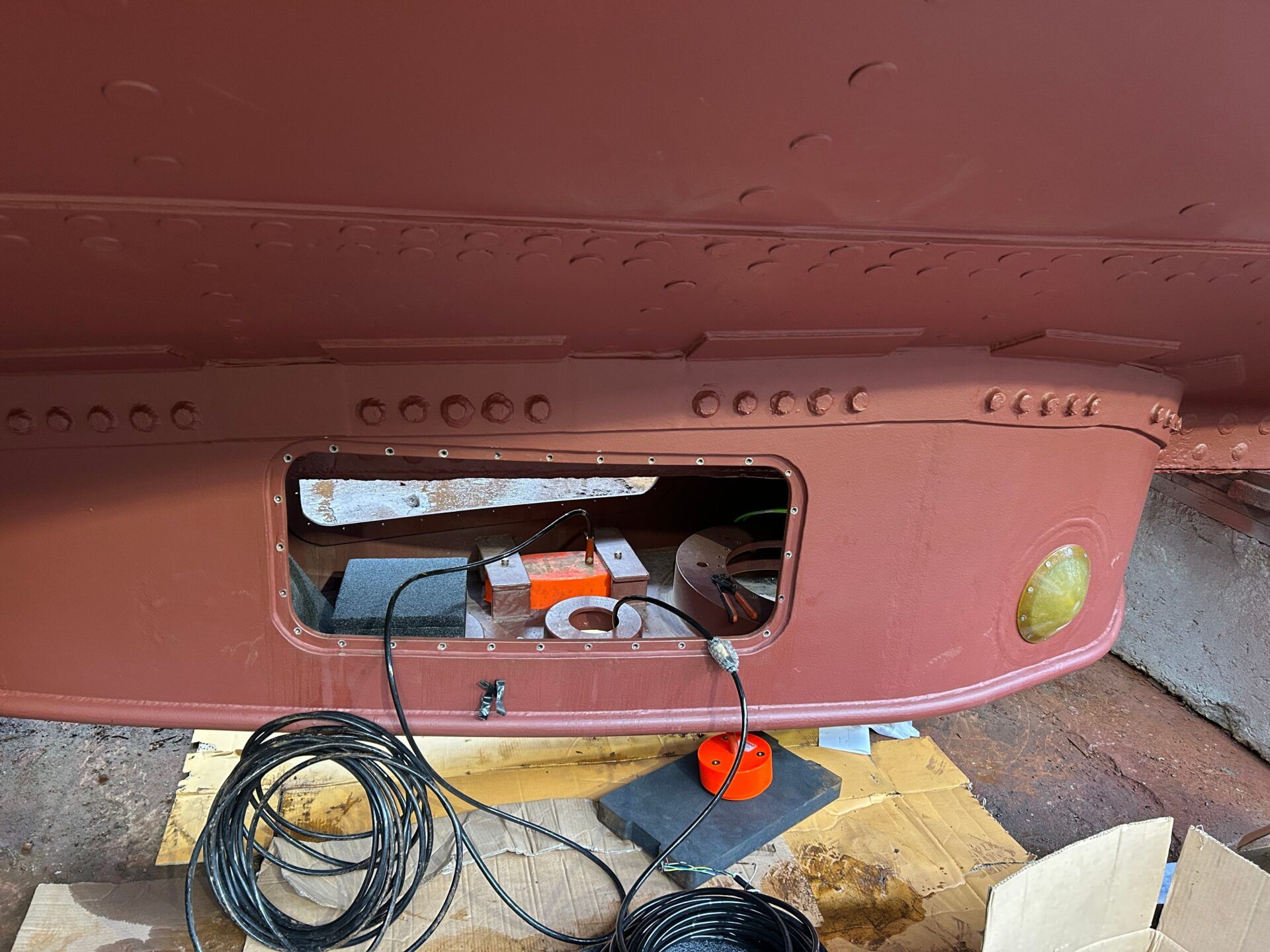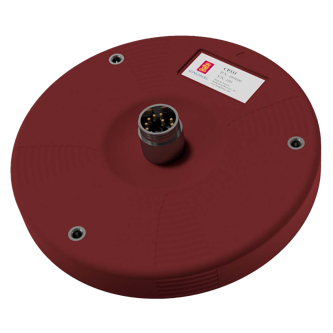Statsraad Lehmkuhl is equipped as a modern research vessel, with a wealth of advanced instruments. One of them is a CP300 scientific echo sounder developed by Kongsberg Maritime.
The CP300 is mounted in an instrument-pod in the bow below the waterline, nicknamed “The Fish”. It measures how much fish, plankton, and other organisms are present in the sea as the ship sails. It also maps the seabed, providing researchers with information about both the life surrounding the ship and the characteristics of the seafloor.
We spoke with one of the developers of the CP300, Olav Langeland. He is a civil engineer, a specialist in hydroacoustics, with over 40 years of experience from Simrad and Kongsberg Discovery.
– I’ve been involved in developing several echosounders over the years, ranging from relatively cheap and simple ones used in fisheries to highly advanced multibeam echosounders used by marine researchers, costing millions for a single instrument, says Olav.

Sound waves underwater
The principle behind an echo sounder is the same no matter how advanced it is, it’s all about sending sound into the water.
– What we call a transducer is a specially designed combination of speaker and microphone, placed underwater, that transmits and receives sound. A regular sound speaker sets air in motion, the transducer moves the water, Olav explains. The principle is the same, although sound travels much faster in water than in air, up to 1600 m/s compared to around 330 m/s in air.
The time it takes for the sound to reflect and return as an echo tells us the distance, making it possible to map the seafloor and detect fish and other objects beneath the ship.

– But we can’t transmit a continuous sound wave, Olav explains. That would just be noise. We emit sound pulses lasting about a millisecond.
The emitted sound has a duration, a frequency, and an amplitude. The amplitude is how much sound is pushed out, the volume, while the frequency determines how high or low the tone is. Human hearing ranges from about 20 hertz to 20,000 hertz - or 20 kHz. Below that range we might feel the vibrations - above it, only dogs and other animals can hear.
From London to Rome
Low-frequency sound waves, deep tones, travel the farthest. Whales communicate using sounds in the 9 to 40 hertz range and can communicate over distances of up to 1500 kilometers- like from London to Rome.
– If you want long-range detection using low frequency, the resolution is poor, explains Olav. To get good resolution, you have to increase the frequency, but then the echosounder’s range becomes shorter.
Resolution refers to how small and detailed the returning echoes can be distinguished?
– Yes, exactly. It’s about how small objects we can distinguish from the noise in the echoes, Olav says. For fishfinding we ended up with a compromise, and there’s a fun story about that: The person who made the first Simrad echo sounder some 70 years ago, wanted to make a 40 kHz transducer, but missed slightly and ended up with 38 kHz. That has since become a standard for fishfinding echosounders.
A 38 kHz transducer can reach depths of up to about 3000 meters. Lower-frequency echosounders can reach much deeper.
– The lowest frequency we use is 12 kHz, which can reach all the way down to the bottom of the deepest oceans at around 11000 meters. But there’s a relationship between frequency and size, the lower the frequency, the larger the transducer, Olav explains.

Multiple tones
Echosounders with transducers from 12 kHz to 700 kHz is used, and for a long time, having multiple frequencies meant installing one transducer for each frequency.
– Most research vessels used to have eight or more different transducers, each operating at its own frequency. Expensive and complex. So some years ago, Simrad started developing what we call composite transducers. These can sweep through a range of frequencies rather than just emitting a single tone, Olav explains.
Like a speaker that can play different tones?
– Sort of, yes. But a bass speaker can’t handle the highest treble, and vice versa. These new transducers can sweep, for example, from 50 to 150 kHz. So you need far fewer transducers, maybe just one.
Are they packed into the same unit?
– It depends on the frequency, but typically a few transducers into one unit. Think of it like a loudspeaker with multiple speaker elements in one housing, with a control unit managing them all.
The transducer functions as both speaker and microphone.
– You emit a signal for just a millisecond, and then the microphone is always on, listening for the echo that returns from whatever the sound wave encounters, says Olav.
When you see a fish on an echo sounder it’s usually the swim bladder reflecting the sound, because it contains air and has a different density than the surrounding water.
– The worst thing in underwater acoustics is air bubbles under the transducer, that ruins everything. That’s why the transducers are mounted in the bow and low enough to stay in water all the time, says Olav.
From analog signals to advanced processing
In earlier times, echosounders were mechanical and required manual interpretation.
– In the old days it was fully analog, kind of like cutting an LP record. A stylus would etch a line on paper, and it was up to the operator to interpret what it meant, Olav explains.

Today, advanced signal processing is used to identify a lot of features in the returned echo. A fish, for instance, will create a small peak in the signal.
A modern echosounder can identify the type and size of a fish - when it is properly calibrated.
– The echo comes from the swim bladder, and its volume changes. The fish moves up and down, and we might see it from different angles, says Olav.
Calibration starts at the factory and continues onboard.
– All scientific surveys begin with calibration. And often, calibration is done again en route, Olav says. Sound speed in water depends on temperature, depth, and salinity. An echo sounder calibrated for the tropics won’t give accurate readings in the Arctic.
Calibration involves lowering and moving a metal sphere with known reflection properties beneath the ship.
– But that only calibrates for the water, not for fish. For that, we need to set a net and analyse the catch right after spotting fish on the echosounder. Then we can correlate echo strength with fish species and size.

Multibeam and ocean currents
Most recreational echosounders emit sound in one single direction. That’s like using a flashlight, you only see part of the room at a time. Modern systems use multibeam technology, emitting sound in multiple directions and combining the echoes into a comprehensive image.

The CP300 onboard Statsraad Lehmkuhl is such a multibeam echosounder, but also a special one.
– The CP in the name stands for "current profiler", Olav says. It functions as a regular echosounder but also measures water current speed and direction. It emits four beams in different directions and analyzes the variations in return signals.
This gives valuable information on the ocean currents in which Statsraad Lehmkuhl is sailing.

From Simrad to Kongsberg
Olav Langeland began his career at Simrad, a pioneer in echo sounder technology.
– Simrad, originally Simonsen Radio, was founded in 1947. The first echo sounders were developed in the 1910s, but Simrad was among the first to make commercial echo sounders for the fishing fleet, says Olav.
Simrad was later acquired by the Kongsberg Group and became part of Kongsberg Maritime, now known as Kongsberg Discovery.
But the Simrad name lives on. In Iceland, people still refer to echo sounders, or bergmálsmælir as it’s formally called in Icelandic, simply as “simrad”.





































